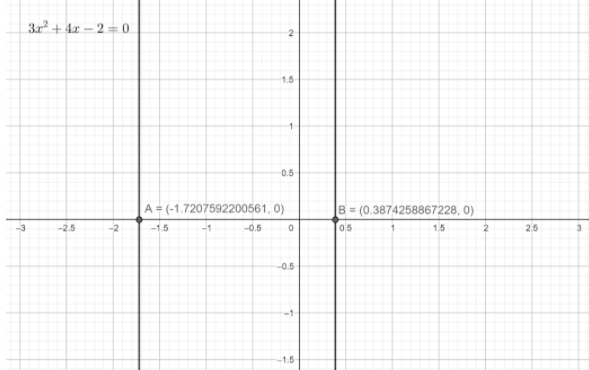Answer
385.5k+ views
Hint: In this problem we need to solve the given quadratic equation i.e., we need to calculate the values of $x$ where the given equation is satisfied. For solving a quadratic equation, we have several methods. But in the problem, they have mentioned to use the quadratic formula which is given by $x=\dfrac{-b\pm \sqrt{{{b}^{2}}-4ac}}{2a}$. For this we need to compare the given equation with the standard quadratic equation $a{{x}^{2}}+bx+c=0$ and write the values of $a$, $b$, $c$. Now we will substitute those values in the formula $x=\dfrac{-b\pm \sqrt{{{b}^{2}}-4ac}}{2a}$ and simplify the obtained equation to get the required result.
Complete step by step answer:
Given equation $3{{x}^{2}}+4x-2=0$.
Comparing the above quadratic equation with standard quadratic equation $a{{x}^{2}}+bx+c=0$, then we will get the values of $a$, $b$, $c$ as
$a=3$, $b=4$, $c=-2$.
We have the quadratic formula for the solution as
$x=\dfrac{-b\pm \sqrt{{{b}^{2}}-4ac}}{2a}$
Substituting the values of $a$, $b$, $c$ in the above equation, then we will get
$\Rightarrow x=\dfrac{-\left( 4 \right)\pm \sqrt{{{\left( 4 \right)}^{2}}-4\left( 3 \right)\left( -2 \right)}}{2\left( 3 \right)}$
We know that when we multiplied a negative sign with the positive sign, then we will get negative sign. Applying the above rule and simplifying the above equation, then we will get
$\begin{align}
& \Rightarrow x=\dfrac{-4\pm \sqrt{16+24}}{6} \\
& \Rightarrow x=\dfrac{-4\pm \sqrt{40}}{6} \\
\end{align}$
In the above equation we have the value $\sqrt{40}$. We need to simplify this value to get the simplified result. We can write $40=10\times 4=10\times {{2}^{2}}$, then the value of $\sqrt{40}$ will be $\sqrt{40}=\sqrt{10\times {{2}^{2}}}=2\sqrt{10}$. Substituting this value in the above equation, then we will get
$\Rightarrow x=\dfrac{-4\pm 2\sqrt{10}}{6}$
Calculating each value individually, then we will get
$\begin{align}
& \Rightarrow x=\dfrac{-4+2\sqrt{10}}{6}\text{ or }\dfrac{-4-2\sqrt{10}}{6} \\
& \Rightarrow x=\dfrac{2\left( -2+\sqrt{10} \right)}{6}\text{ or }\dfrac{2\left( -2-\sqrt{10} \right)}{6} \\
& \Rightarrow x=\dfrac{-2+\sqrt{10}}{3}\text{ or }\dfrac{-2-\sqrt{10}}{3} \\
\end{align}$
Hence the solution of the given quadratic equation $3{{x}^{2}}+4x-2=0$ are $x=\dfrac{-2\pm \sqrt{10}}{3}$.
Note: We can also see the graph of the above given equation to observe the roots of the equation. When we plot the graph of the given equation $3{{x}^{2}}+4x-2=0$ it looks like below graph

From the above graph also, we can say that the roots of the given equation $3{{x}^{2}}+4x-2=0$ are $x=\dfrac{-2\pm \sqrt{10}}{3}$.
Complete step by step answer:
Given equation $3{{x}^{2}}+4x-2=0$.
Comparing the above quadratic equation with standard quadratic equation $a{{x}^{2}}+bx+c=0$, then we will get the values of $a$, $b$, $c$ as
$a=3$, $b=4$, $c=-2$.
We have the quadratic formula for the solution as
$x=\dfrac{-b\pm \sqrt{{{b}^{2}}-4ac}}{2a}$
Substituting the values of $a$, $b$, $c$ in the above equation, then we will get
$\Rightarrow x=\dfrac{-\left( 4 \right)\pm \sqrt{{{\left( 4 \right)}^{2}}-4\left( 3 \right)\left( -2 \right)}}{2\left( 3 \right)}$
We know that when we multiplied a negative sign with the positive sign, then we will get negative sign. Applying the above rule and simplifying the above equation, then we will get
$\begin{align}
& \Rightarrow x=\dfrac{-4\pm \sqrt{16+24}}{6} \\
& \Rightarrow x=\dfrac{-4\pm \sqrt{40}}{6} \\
\end{align}$
In the above equation we have the value $\sqrt{40}$. We need to simplify this value to get the simplified result. We can write $40=10\times 4=10\times {{2}^{2}}$, then the value of $\sqrt{40}$ will be $\sqrt{40}=\sqrt{10\times {{2}^{2}}}=2\sqrt{10}$. Substituting this value in the above equation, then we will get
$\Rightarrow x=\dfrac{-4\pm 2\sqrt{10}}{6}$
Calculating each value individually, then we will get
$\begin{align}
& \Rightarrow x=\dfrac{-4+2\sqrt{10}}{6}\text{ or }\dfrac{-4-2\sqrt{10}}{6} \\
& \Rightarrow x=\dfrac{2\left( -2+\sqrt{10} \right)}{6}\text{ or }\dfrac{2\left( -2-\sqrt{10} \right)}{6} \\
& \Rightarrow x=\dfrac{-2+\sqrt{10}}{3}\text{ or }\dfrac{-2-\sqrt{10}}{3} \\
\end{align}$
Hence the solution of the given quadratic equation $3{{x}^{2}}+4x-2=0$ are $x=\dfrac{-2\pm \sqrt{10}}{3}$.
Note: We can also see the graph of the above given equation to observe the roots of the equation. When we plot the graph of the given equation $3{{x}^{2}}+4x-2=0$ it looks like below graph

From the above graph also, we can say that the roots of the given equation $3{{x}^{2}}+4x-2=0$ are $x=\dfrac{-2\pm \sqrt{10}}{3}$.
Recently Updated Pages
How many sigma and pi bonds are present in HCequiv class 11 chemistry CBSE

Why Are Noble Gases NonReactive class 11 chemistry CBSE

Let X and Y be the sets of all positive divisors of class 11 maths CBSE

Let x and y be 2 real numbers which satisfy the equations class 11 maths CBSE

Let x 4log 2sqrt 9k 1 + 7 and y dfrac132log 2sqrt5 class 11 maths CBSE

Let x22ax+b20 and x22bx+a20 be two equations Then the class 11 maths CBSE

Trending doubts
Fill the blanks with the suitable prepositions 1 The class 9 english CBSE

At which age domestication of animals started A Neolithic class 11 social science CBSE

Which are the Top 10 Largest Countries of the World?

Give 10 examples for herbs , shrubs , climbers , creepers

Difference between Prokaryotic cell and Eukaryotic class 11 biology CBSE

Difference Between Plant Cell and Animal Cell

Write a letter to the principal requesting him to grant class 10 english CBSE

Change the following sentences into negative and interrogative class 10 english CBSE

Fill in the blanks A 1 lakh ten thousand B 1 million class 9 maths CBSE



